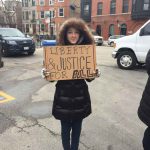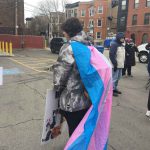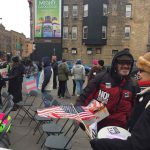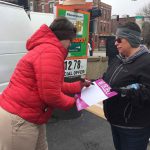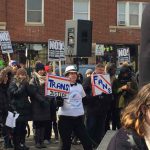By Haley Velasco
To protect transgender rights, hundreds of people protested in Lakeview on February 25. Protesters gathered in the 7-Eleven parking lot at 3407 N. Halsted St. The event featured speakers, including LGBT activists and local politicians, before marching down North Halsted Street in protest. Despite the few hundred that showed, many chose to stay away, citing a lack of transgender individuals organizing the event, as well as a general lack of trust in the Boystown community, especially from minority transgender people.
“I saw that the march was happening, but I didn’t see [any] trans organizers,” said LaSaia Wade, an Afro-Indigenous Latinx trans woman and organizer. “It was cis, white-led and I made a fuss. That’s just me, that’s what I do. I asked where are the trans organizers? … More trans people came in and we started to make a bigger fuss. They started adding more trans people in at the last minute to organize and help organize with the march but we didn’t have a representation of trans people in this particular march.”
Protestors at the event, titled Stand Up for Transgender Rights: Chicago on Facebook, carried a plethora of signs, some which read “Trans Rights Are Human Rights” or “It was never about bathrooms. Just like it was never like water fountains.” The event featured speakers from LGBT organizations, such as the Center on Halsted and Equality Illinois, who criticized President Donald Trump, Secretary of Education Betsy DeVos and Attorney General Jeff Sessions for rescinding the federal directive, as well as calling for equality and protection for the transgender community.
We reported live from the event on Snapchat; you can view the video below.
President Trump removed a federal directive on Feb. 22 that the Obama administration instituted that allowed transgender students to use the bathroom and locker room that matched their gender identity. This action sparked the organizers to organize and create the protest.
“To see this administration continue a message of hate and disunity, I’m just furious and fed up. When the administration made this decision, I knew that something had to be done,” said Kevin Borrini Morrison, one of the event’s co-organizers.
The National Coalition of Anti-Violence Programs reported a multi-year trend in 2015 that shows that transgender women experience a greater risk of death by hate violence than any other group. Keke Collier, 24 years old, was shot and killed on Feb. 21 on Chicago’s Englewood neighborhood. Collier is the seventh person killed in 2017 from anti-transgender violence, according to GLAAD’s list of transgender victims of crime as of March 1.
“We are no longer going to allow anyone to push us aside. We are members of the human race. We are members of this society. And we demand the respect and the dignity that every other member, resident or citizen of this country gets,” said Maritxa Vidal, a transgender woman and president of the TransLatin@ Coalition‘s Chicago chapter, who spoke at the protest.
Mayor Rahm Emanuel said on Feb. 22 that the city and Chicago Public Schools would not change its policies that support transgender students, despite the rollback from Trump.
“We all have to stand together against this [presidential] administration. … We are the most marginalized, the most mistreated community in the world,” Vidal said.
With the beat of a drum in the background, the rally turned into a march as the protesters headed north on Halsted chanting, “Trans rights are human rights.”
However, absent from the protest planning were transgender organizers, especially people of color. Through the Facebook event prior to the protest, many voiced their concerns that the organizers, all four who are white cisgender men, would not accurately represent the transgender community or its concerns.
“It was honestly ridiculous that the organizers kept ignoring the concerns of actual trans people and still held a march,” said Adrian Summerville, who publicly criticized the organizers during the planning of the event. “To listen to our community means listening to the most marginalized among us, which would be trans women of color. It wasn’t until several people pointed out Keke Collier’s murder that they finally mentioned her. We are now sitting at seven trans women of color murdered in two months. That should have been front and center. The bathroom protection being rescinded is merely a symptom of the bigger problem that our society has with trans people and people of color.”
In addition to the event itself, Boystown has been criticized for years for not being welcoming to people of color. Some go as far as calling the area, “white boys’ town,” pointing out a lack of racial diversity, as well as gender inclusivity in practice and its name.
“There is a high policing in Boystown, especially for trans, gender non-conforming people of color. … There’s [also] high policing around gay black people in Boystown,” Wade said. “It’s an area that’s name needs to be changed. It’s highly gendered. Number two, the area is highly unsafe for people of color, [especially] black folks.”
Wade, an organizer for a protest that occurred March 3 called Trans Liberation Protest Chicago, noted a distrust of law enforcement that many transgender people, especially racial minority, have.
“I feel safer around drug dealers than I do police officers,” Wade said.



